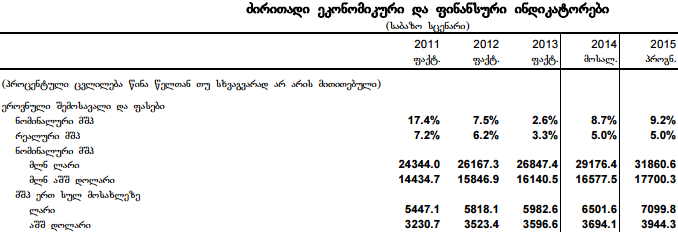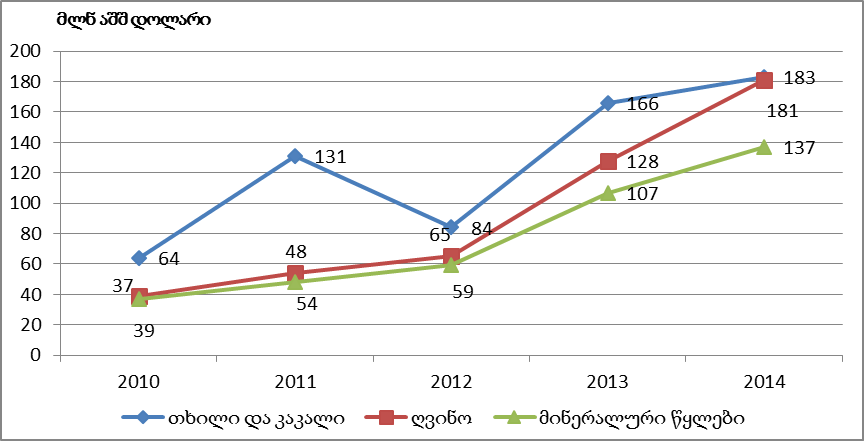On 28 April 2015, on air on the talk show,
Choice, the Leader of the United National Movement, Davit Bakradze, talked about the worsened external trade indicators. He pointed out that Georgia’s five main export commodities decreased significantly.
FactCheck looked into the accuracy of the aforementioned statement.
Georgia’s exports had a high growth rate at the beginning of 2014; however, the growth rate started to decrease in the second half of the year and, overall, exports decreased by 2% in 2014. In the first quarter of 2015, despite the fact that exports to European Union member states increased by 21%, exports to Commonwealth of Independent States members decreased by 55%. Overall, exports decreased by 28% in the first quarter of 2015.
Table 1: Export by Groups of Countries (2014 and the First Quarter of 2015, USD million)
|
2014 |
2015 |
Change |
| EU Member States |
140 |
170 |
21% |
| Commonwealth of Independent States Members |
391 |
175 |
-55% |
| Other Countries |
164 |
158 |
-4% |
| Overall |
695 |
503 |
-28% |
Source: National Statistics Office of Georgia
According to the data of the National Statistics Office of Georgia, motor vehicles (18%), ferroalloys (10%), copper ores (9%), nuts (6%) and wine (6%) made up Georgia’s top five export commodities in 2014. Nitrogenous fertilisers (5%) and mineral waters (5%) occupied the 6
th and 7
th positions, respectively.
Table 2: Five Largest Export Commodities (2013-2014)
| 2013 |
Value (USD Million) |
Share in Overall Exports |
2014 |
Value (USD Million) |
Share in Overall Exports |
| Motor Vehicles |
704 |
24% |
Motor Vehicles |
518 |
18% |
| Ferroalloys |
230 |
8% |
Ferroalloys |
286 |
10% |
| Nuts and Walnuts |
167 |
6% |
Copper Ores |
248 |
9% |
| Copper Ores |
162 |
6% |
Nuts and Walnuts |
183 |
6% |
| Nitrogenous Fertilisers |
131 |
4% |
Wine |
181 |
6% |
Source: National Statistics Office of Georgia
As pointed out earlier, exports started to decrease in the second half of 2014 and the trend continues today as well. According to the data of the National Statistics Office of Georgia, the sales of Georgia’s major export commodities decreased in the first quarter of 2015 as compared to the same period of the previous year. Exports of wine (-67%) and alcoholic beverages (59%) decreased due in the main to the negative processes taking place on the Russian market. As for the export of motor vehicles which have been Georgia’s single largest export commodity in recent years, it decreased by 62%. Exports of ferroalloys (-31%), mineral water (-32%) and nitrogenous fertilisers (-47%) have also gone down. However, it should be pointed out that exports of copper ores (19%) and nuts (139%) have increased as compared to the same period of the previous year.
Graph 1: Dynamics of Main Export Commodities (2010-2014)
 Source: National Statistics Office of Georgia
Source: National Statistics Office of Georgia
The opening of the Russian market at the end of 2012 had a positive influence upon Georgian exports. As Chart 2 illustrates, the export of wine, mineral water and nuts doubled in 2012 and 2013. However, the economic process in Russia at the end of 2014 had a serious influence upon Georgian exports.
Graph 2: Dynamics of Main Export Commodities (2010-2014)
 Source: National Statistics Office of Georgia
Conclusion
Source: National Statistics Office of Georgia
Conclusion
Motor vehicles, ferroalloys, wine, mineral water and nuts were Georgia’s main export commodities from 2012 to 2014. The opening of the Russian market at the end of 2012 had a positive influence upon Georgian exports. Sales of wine and mineral water almost doubled in 2012 and 2013; however, exports started to go down at the end of 2014.
Exports decreased by 28% in the first quarter of 2015 as compared to the same period of the previous year. Motor vehicles, ferroalloys, copper ores, nuts and wine made up Georgia’s top five export commodities in 2014. The export of motor vehicles (-62%), ferroalloys (-31%) and wine (-67%) decreased significantly. However, the MP did not point out the fact that exports of nuts and walnuts (139%) and copper ores (19%) have increased.
FactCheck concludes that Davit Bakradze’s statement in
MOSTLY TRUE.
 Source: National Statistics Office of Georgia
The opening of the Russian market at the end of 2012 had a positive influence upon Georgian exports. As Chart 2 illustrates, the export of wine, mineral water and nuts doubled in 2012 and 2013. However, the economic process in Russia at the end of 2014 had a serious influence upon Georgian exports.
Graph 2: Dynamics of Main Export Commodities (2010-2014)
Source: National Statistics Office of Georgia
The opening of the Russian market at the end of 2012 had a positive influence upon Georgian exports. As Chart 2 illustrates, the export of wine, mineral water and nuts doubled in 2012 and 2013. However, the economic process in Russia at the end of 2014 had a serious influence upon Georgian exports.
Graph 2: Dynamics of Main Export Commodities (2010-2014)
 Source: National Statistics Office of Georgia
Conclusion
Motor vehicles, ferroalloys, wine, mineral water and nuts were Georgia’s main export commodities from 2012 to 2014. The opening of the Russian market at the end of 2012 had a positive influence upon Georgian exports. Sales of wine and mineral water almost doubled in 2012 and 2013; however, exports started to go down at the end of 2014.
Exports decreased by 28% in the first quarter of 2015 as compared to the same period of the previous year. Motor vehicles, ferroalloys, copper ores, nuts and wine made up Georgia’s top five export commodities in 2014. The export of motor vehicles (-62%), ferroalloys (-31%) and wine (-67%) decreased significantly. However, the MP did not point out the fact that exports of nuts and walnuts (139%) and copper ores (19%) have increased.
FactCheck concludes that Davit Bakradze’s statement in MOSTLY TRUE.
Source: National Statistics Office of Georgia
Conclusion
Motor vehicles, ferroalloys, wine, mineral water and nuts were Georgia’s main export commodities from 2012 to 2014. The opening of the Russian market at the end of 2012 had a positive influence upon Georgian exports. Sales of wine and mineral water almost doubled in 2012 and 2013; however, exports started to go down at the end of 2014.
Exports decreased by 28% in the first quarter of 2015 as compared to the same period of the previous year. Motor vehicles, ferroalloys, copper ores, nuts and wine made up Georgia’s top five export commodities in 2014. The export of motor vehicles (-62%), ferroalloys (-31%) and wine (-67%) decreased significantly. However, the MP did not point out the fact that exports of nuts and walnuts (139%) and copper ores (19%) have increased.
FactCheck concludes that Davit Bakradze’s statement in MOSTLY TRUE.
 Source: National Statistics Office of Georgia
The opening of the Russian market at the end of 2012 had a positive influence upon Georgian exports. As Chart 2 illustrates, the export of wine, mineral water and nuts doubled in 2012 and 2013. However, the economic process in Russia at the end of 2014 had a serious influence upon Georgian exports.
Graph 2: Dynamics of Main Export Commodities (2010-2014)
Source: National Statistics Office of Georgia
The opening of the Russian market at the end of 2012 had a positive influence upon Georgian exports. As Chart 2 illustrates, the export of wine, mineral water and nuts doubled in 2012 and 2013. However, the economic process in Russia at the end of 2014 had a serious influence upon Georgian exports.
Graph 2: Dynamics of Main Export Commodities (2010-2014)
 Source: National Statistics Office of Georgia
Conclusion
Motor vehicles, ferroalloys, wine, mineral water and nuts were Georgia’s main export commodities from 2012 to 2014. The opening of the Russian market at the end of 2012 had a positive influence upon Georgian exports. Sales of wine and mineral water almost doubled in 2012 and 2013; however, exports started to go down at the end of 2014.
Exports decreased by 28% in the first quarter of 2015 as compared to the same period of the previous year. Motor vehicles, ferroalloys, copper ores, nuts and wine made up Georgia’s top five export commodities in 2014. The export of motor vehicles (-62%), ferroalloys (-31%) and wine (-67%) decreased significantly. However, the MP did not point out the fact that exports of nuts and walnuts (139%) and copper ores (19%) have increased.
FactCheck concludes that Davit Bakradze’s statement in MOSTLY TRUE.
Source: National Statistics Office of Georgia
Conclusion
Motor vehicles, ferroalloys, wine, mineral water and nuts were Georgia’s main export commodities from 2012 to 2014. The opening of the Russian market at the end of 2012 had a positive influence upon Georgian exports. Sales of wine and mineral water almost doubled in 2012 and 2013; however, exports started to go down at the end of 2014.
Exports decreased by 28% in the first quarter of 2015 as compared to the same period of the previous year. Motor vehicles, ferroalloys, copper ores, nuts and wine made up Georgia’s top five export commodities in 2014. The export of motor vehicles (-62%), ferroalloys (-31%) and wine (-67%) decreased significantly. However, the MP did not point out the fact that exports of nuts and walnuts (139%) and copper ores (19%) have increased.
FactCheck concludes that Davit Bakradze’s statement in MOSTLY TRUE.







